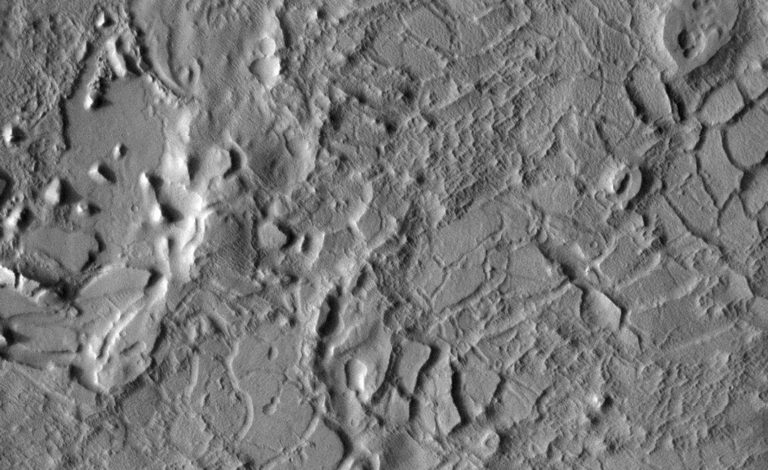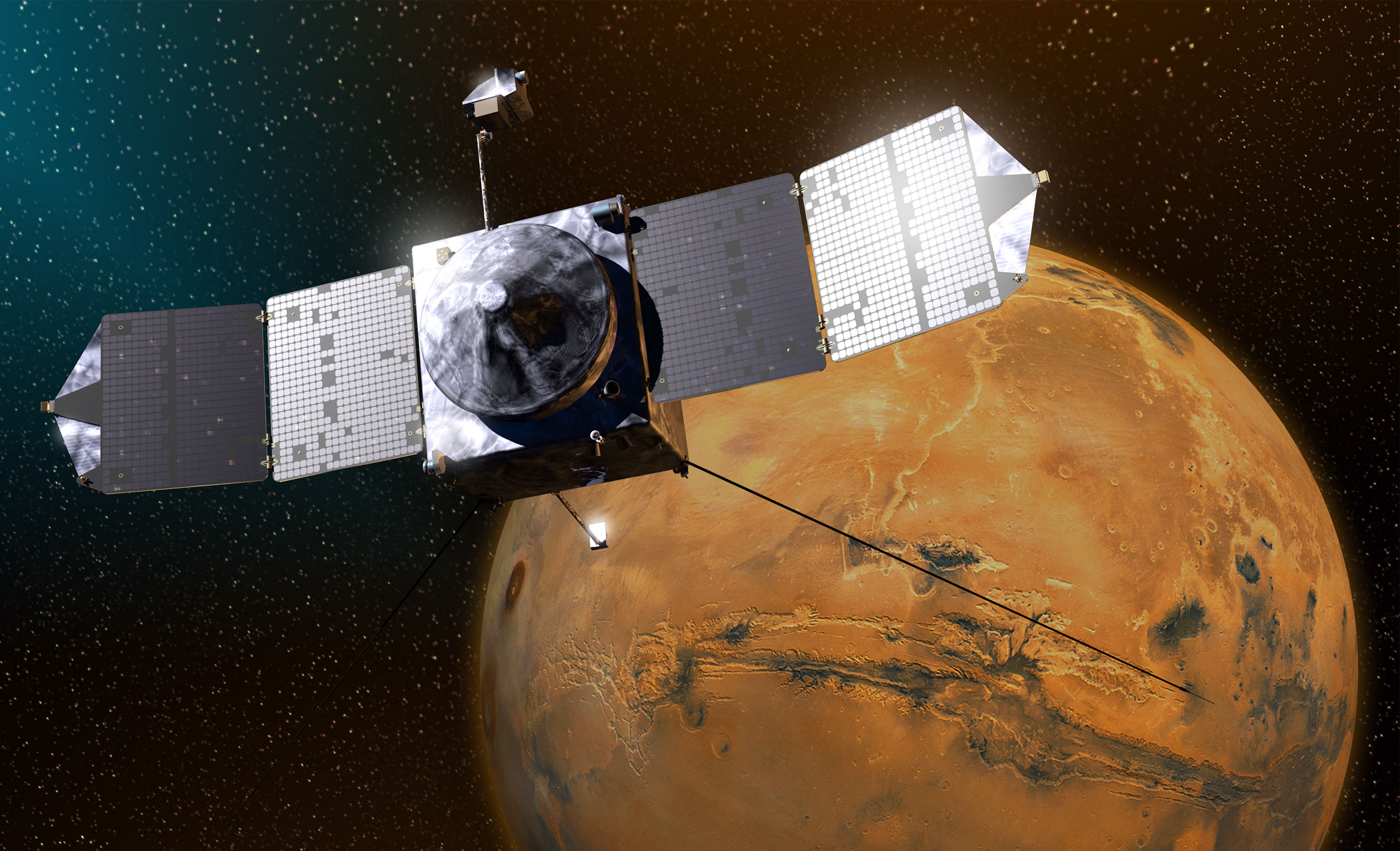Billions of years ago, Mars was once a much different place than the cold and desiccated place it is today. Basically, it had a thicker, warmer atmosphere and liquid water flowing on its surface, and maybe even life! The reason for this is because, like Earth, Mars had a planetary magnetic field that was generated by action in its core. But when that field disappeared, things began to change drastically!
For years, scientists believed that this field disappeared over 4 billion years ago, causing Mars’ atmosphere to be slowly stripped away by solar wind. But according to new research led by the University of British Columbia (UBC) has placed new constraints on when this magnetic field disappeared, indicating that Mars’ magnetic field existed sooner (and laster hundreds of millions of years longer) than previously thought.
The study that describes their findings, which recently appeared in the journal Science Advances, was led by Anna Mittelholz – a postdoctoral fellow with UBC’s Department of Earth, Ocean and Atmospheric Sciences. She was joined by Catherine Johnson, a Senior Scientist at the Planetary Science Institute (PSI), and an international team of researchers.

Like Earth, Mars global magnetic field is believed to have been the result of a dynamo effect caused by action in its core. This occurs when a liquid outer core revolves around a solid outer core, in the opposite direction of the planet’s rotation. Unfortunately, the magnetic field disappeared, which caused the planet’s atmosphere to be stripped over time to the point that it became extremely thin (as it is today).
Scientists attribute this to Mars’ lower mass and density (compared to Earth) which resulted in its interior cooling more rapidly. This caused the planet’s outer core to become solid, thus arresting the Martian dynamo effect. Meanwhile, its inner core is believed to be in a liquid state because the pressure in Mars’ interior is too low to cause it to solidify.
In the past, scientists have relied on the study of magnetized rocks on and beneath the surface of Mars to reconstruct the history of the planet’s magnetic field – especially lava rocks. This type of rock originates in the planet’s mantle and is then brought to the surface through volcanic activity and resurfacing. As the lava is exposed to the surface and cools, its minerals align themselves with the global magnetic field.
After examining magnetized samples of surface rock, scientists found that a dynamo was active between 4.3 and 4.2 billion years ago. However, rock samples that were taken from three large Basins – Hellas, Argyre, and Isidis – which formed 3.9 billion years ago – led most scientists to the conclusion that the dynamo was inactive by this time.
But after analyzing new data obtained by NASA’s Mars Atmosphere and Volatile EvolutioN (MAVEN) orbiter, the team was presented with a different picture. As Mittelholz explained in a recent UBC press release:
“We find that the Martian dynamo operated at 4.5 billion years ago (4.5 Ga) and 3.7 billion years ago. Dynamo timing is a big part of a planet’s evolution, and what we find is very different from what we have thought so far. The dynamo tells us something about the planet’s thermal history, its evolution, and how it got to where it is today, and it is unique for each of the terrestrial planets – Earth, Mars, Venus and Mercury.”
Previous data about magnetism on Mars was gathered by the Mars Global Surveyor (MGS) satellite, which orbited the Red Planet between 1999 and 2006. For the most part, this NASA mission conducted its observations while at a distance of 400 km (250 mi) from the surface. The MAVEN mission, which began orbiting Mars in 2014, was able to pick up weaker signals since it operated as close as 135 km (84 mi) from the surface.
The new MAVEN data detected clear evidence of a magnetic field coming from the Lucus Planum lava flow, which formed about 3.7 billion years ago and showed evidence of a magnetic field. This indicates that a Martian magnetic field existed much later than what previous studies from other areas have suggested.

As Johnson – who is also a professor in the Department of Earth, Ocean and Atmospheric Sciences at UBC and Mittelholz’s academic advisor – explained:
“The age for the newer dynamo comes from the correlation of magnetic signals with a young (3.7 Ga) lava flow. In particular we see a ‘hole’ in the magnetic field signal over a small crater in the flow that penetrates to the base of the flow so we know that this small crater removed the magnetic signal: this tells us that the magnetized rocks are in the flow, not just buried much more deeply. The flow age comes from crater counts on the flow.”
In addition, they noted the presence of a low-intensity magnetic field over the Borealis Basin in the planet’s northern hemisphere. This is one of the oldest features on Mars, having formed 4.5 billion years ago, at a time when Mars itself was just over 100 million years old. These two observations point to the existence of a dynamo very early in Mars’ history and that it lasted half a billion years longer than many scientists thought.
To explain the absence of magnetized rocks in the Hellas, Argyre, and Isidis Basins, the researchers offer two possible explanations. On the one hand, the dynamo may have stopped before these basins formed and restarted later. On the other, it is possible that the impacts that formed them displaced the crust that contained the minerals that could carry a strong magnetic signature.

In any case, these results could reveal new insights into Mars’ geological history and its interior structure. As Johnson explained:
“If a rocky planet or moon has a global magnetic field like on Earth either today or sometime in the past, it tells us about the planet’s deep interior at that time. Furthermore, new results for the dynamo at 3.7 Ga suggest that the Martian dynamo could have been active at a time of very different climatic conditions on Mars, in particular when many of the valley networks formed.”
In particular, it was MAVEN’s ability to pick up signals from smaller features on and near the surface that allowed the research team to distinguish between is coming from the surface or from older rocks buried deeper in the crust. In any case, these new insights have scientists wondering what they could find if they could look even closer.
Mars is rife with craters, after all, and future missions will be able to examine them more closely – especially where rovers or balloons are involved. For instance, the Perseverance rover lands on Mars in 2021, it will be landing in the Jezero crater – which is located at the edge of the Isidris Basin. In addition to finding evidence of past habitability (and possibly past life, fingers crossed!) it could also reveal things about Mars’ geological past.
Further Reading: UBC, PSI, Science Advances


“”Furthermore, new results for the dynamo at 3.7 Ga suggest that the Martian dynamo could have been active at a time of very different climatic conditions on Mars, in particular when many of the valley networks formed.””
To wit:
“New highly detailed images and data of exposed cliffs on Mars reveal the first evidence of rivers that existed for more than 100,000 years on the Martian surface 3.7 billion years ago, according to a study published Tuesday in the journal Nature Communications.”
“Based on the evidence they found in the orbital data, the researchers believe that the planet’s water was driven by precipitation, like the rain we experience on Earth, and had a sustained presence 3.7 billion years ago.”
[ https://edition.cnn.com/2020/05/05/world/mars-river-evidence-scn-trnd/index.html ]
“The new model proposes that the oceans formed before or at the same time as Mars’ largest volcanic feature, Tharsis, instead of after Tharsis formed 3.7 billion years ago. Because Tharsis was smaller at that time, it did not distort the planet as much as it did later, in particular the plains that cover most of the northern hemisphere and are the presumed ancient seabed. The absence of crustal deformation from Tharsis means the seas would have been shallower, holding about half the water of earlier estimates.”
“The model also counters another argument against oceans: that the proposed shorelines are very irregular, varying in height by as much as a kilometer, when they should be level, like shorelines on Earth.
This irregularity could be explained if the first ocean, called Arabia, started forming about 4 billion years ago and existed, if intermittently, during as much as the first 20 percent of Tharsis’s growth. The growing volcano would have depressed the land and deformed the shoreline over time, which could explain the irregular heights of the Arabia shoreline.
Similarly, the irregular shoreline of a subsequent ocean, called Deuteronilus, could be explained if it formed during the last 17 percent of Tharsis’s growth, about 3.6 billion years ago.
“These shorelines could have been emplaced by a large body of liquid water that existed before and during the emplacement of Tharsis, instead of afterwards,” said first author Robert Citron, a UC Berkeley graduate student. Citron will present a paper about the new analysis on March 20 at the annual Lunar and Planetary Science conference in Texas.”
[ https://news.berkeley.edu/2018/03/19/mars-oceans-formed-early-possibly-aided-by-massive-volcanic-eruptions/ ]
When Did Mars Lose its Global Magnetic Field? – September 29 1847 B.C.
? Not in the geological record. The global magnetic field is never completely lost on Earth – the latest field reversal when it is flipped with complicated behavior – is much older, and on Mars it was likely similarly persistent until the geodynamo was lost. Local data (martian meteorites, lander data) show that the loss was in geological time, and the article above describe the current observations of loss sometime over 3 billion years ago.